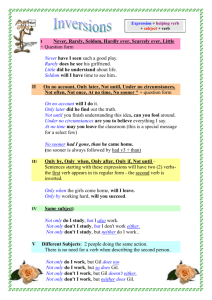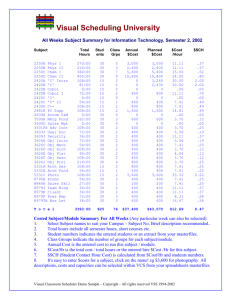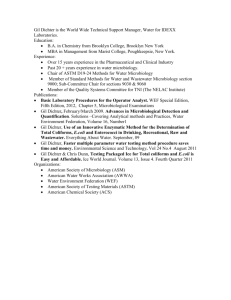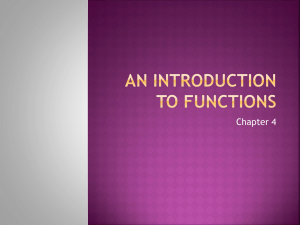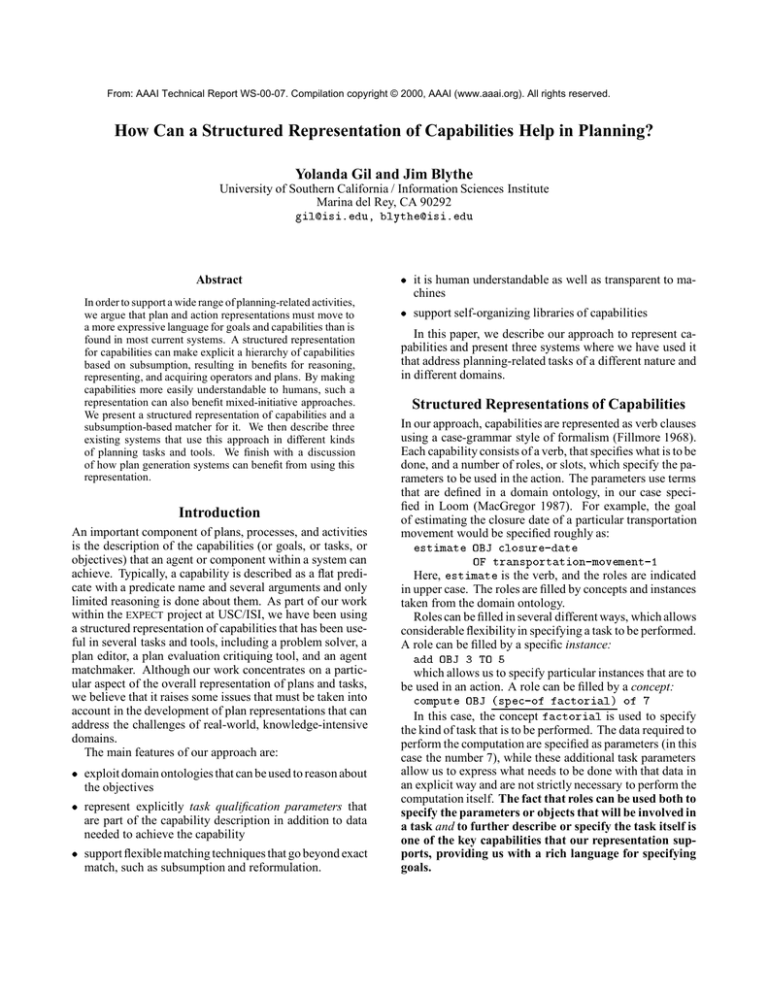
From: AAAI Technical Report WS-00-07. Compilation copyright © 2000, AAAI (www.aaai.org). All rights reserved.
How Can a Structured Representation of Capabilities Help in Planning?
Yolanda Gil and Jim Blythe
University of Southern California / Information Sciences Institute
Marina del Rey, CA 90292
gil@isi.edu, blythe@isi.edu
Abstract
In order to support a wide range of planning-related activities,
we argue that plan and action representations must move to
a more expressive language for goals and capabilities than is
found in most current systems. A structured representation
for capabilities can make explicit a hierarchy of capabilities
based on subsumption, resulting in benefits for reasoning,
representing, and acquiring operators and plans. By making
capabilities more easily understandable to humans, such a
representation can also benefit mixed-initiative approaches.
We present a structured representation of capabilities and a
subsumption-based matcher for it. We then describe three
existing systems that use this approach in different kinds
of planning tasks and tools. We finish with a discussion
of how plan generation systems can benefit from using this
representation.
Introduction
An important component of plans, processes, and activities
is the description of the capabilities (or goals, or tasks, or
objectives) that an agent or component within a system can
achieve. Typically, a capability is described as a flat predicate with a predicate name and several arguments and only
limited reasoning is done about them. As part of our work
within the EXPECT project at USC/ISI, we have been using
a structured representation of capabilities that has been useful in several tasks and tools, including a problem solver, a
plan editor, a plan evaluation critiquing tool, and an agent
matchmaker. Although our work concentrates on a particular aspect of the overall representation of plans and tasks,
we believe that it raises some issues that must be taken into
account in the development of plan representations that can
address the challenges of real-world, knowledge-intensive
domains.
The main features of our approach are:
exploit domain ontologies that can be used to reason about
the objectives
represent explicitly task qualification parameters that
are part of the capability description in addition to data
needed to achieve the capability
support flexible matching techniques that go beyond exact
match, such as subsumption and reformulation.
it is human understandable as well as transparent to machines
support self-organizing libraries of capabilities
In this paper, we describe our approach to represent capabilities and present three systems where we have used it
that address planning-related tasks of a different nature and
in different domains.
Structured Representations of Capabilities
In our approach, capabilities are represented as verb clauses
using a case-grammar style of formalism (Fillmore 1968).
Each capability consists of a verb, that specifies what is to be
done, and a number of roles, or slots, which specify the parameters to be used in the action. The parameters use terms
that are defined in a domain ontology, in our case specified in Loom (MacGregor 1987). For example, the goal
of estimating the closure date of a particular transportation
movement would be specified roughly as:
estimate OBJ closure-date
OF transportation-movement-1
Here, estimate is the verb, and the roles are indicated
in upper case. The roles are filled by concepts and instances
taken from the domain ontology.
Roles can be filled in several different ways, which allows
considerable flexibility in specifying a task to be performed.
A role can be filled by a specific instance:
add OBJ 3 TO 5
which allows us to specify particular instances that are to
be used in an action. A role can be filled by a concept:
compute OBJ (spec-of factorial) of 7
In this case, the concept factorial is used to specify
the kind of task that is to be performed. The data required to
perform the computation are specified as parameters (in this
case the number 7), while these additional task parameters
allow us to express what needs to be done with that data in
an explicit way and are not strictly necessary to perform the
computation itself. The fact that roles can be used both to
specify the parameters or objects that will be involved in
a task and to further describe or specify the task itself is
one of the key capabilities that our representation supports, providing us with a rich language for specifying
goals.
Roles can be a type of an instance, as in:
method
hierarchy
divide OBJ (inst-of number) BY 2
This expresses a generic goal that can be instantiated with
any elements of that type.
Roles can also be filled by extensional sets as in:
find OBJ (spec-of maximum) OF (42 2 99)
or they can be filled by intensional sets, where the set is
described by a concept:
Finally, it is possible to use descriptions (which are similar
to the definitions of Loom concepts) in roles:
estimate OBJ support-personnel
IN (and location (exactly 0 seaports))
This is a goal to estimate the support personnel in a location with no seaports.
This approach provides us with a rich language for specifying behaviors. The case grammar formalism makes it
relatively straightforward to paraphrase the goals into natural language, helping to make them more understandable
(Swartout, Paris, & Moore 1991).
An important aspect of the systems we have implemented
that use this expressive representation is how they reason
with it, exploiting subsumption and reformulation as we
describe next. Further details can be found in (Swartout &
Gil 1995; Gil & Melz 1996). Capabilities are translated into
Loom definitions, following an algorithm described in (Gil
& Gonzalez 1996). For example,
compute OBJ (spec-of factorial) OF (5 7)
is translated into:
(defconcept compute-factorial-of-numbers
:is (:and compute
(:the obj (:and concept-description factorial))
(:the of (:and number extensional-instance-set
(:filled-by instance-name 5)
(:filled-by instance-name 7)))))
Loom’s classifier reasons about these definitions and
places them in a lattice, where more general definitions
subsume more specific ones. Notice that this subsumption
reasoning uses the definitions of the domain terms and ontologies that are contained in the domain knowledge bases.
For example, the capability to “move cargo with a vehicle”
will subsume one to “move cargo with an aircraft”, because
according to the domain ontologies vehicle subsumes aircraft. This is illustrated in the hierarchy shown in Figure 1.
As a result, the capabilities are automatically organized according to subsumption, and they can be compared based
on their place in the lattice.
Subsumption matching can help find suitable capabilities
when presented with a query, but in some cases no subsuming capability has been added to the knowledge base. In
these cases it may be possible to fulfill the request through
a goal reformulation. This allows a more flexible matching
than is possible if one required an exact match for goals
and methods. A goal reformulation is a form of divide and
conquer. It transforms a goal into a set of goals that partition the original goal. For example, suppose a goal of
estimating support personnel has been posted, and that the
domain ontology indicates that the concept support personnel is partitioned into unloading personnel, seaport support
move
Capability:
move
OBJ (inst-of cargo)
WITH (inst-of aircraft)
find OBJ (set-of (spec-of violated-constraint))
IN (inst-of configuration)
OBJ
move
OBJ
move
goal-1
vehicle
OBJ
cargo
move
aircraft
WITH
method-1
WITH
method-2
cargo
OBJ
cargo
WITH
method-3
ship
cargo
Goal:
WITH
C-140
move
OBJ (inst-of cargo)
WITH C-140
Figure 1: Translating capabilities into Loom descriptions
personnel and airport support personnel. The original goal
can then be reformulated into three new goals to estimate
each type of personnel in the partition. In our approach we
support several types of reformulations. For more details,
see (Swartout & Gil 1995).
Goal reformulations allow us to state the description of
method capabilities more independently from the descriptions of the goals that are posted by other methods or by the
user. The benefit is a more loose coupling between methods
and tasks, i.e., between what is to be accomplished and what
are possible ways to accomplish it.
We have used these structured representations of objectives in several systems that we now describe.
EXPECT
is a reasoning system that supports acquisition of
problem-solving knowledge through several different techniques. These include maintaining a dependency model
of any knowledge-based system (KBS) that is built with
EXPECT, scripting tools that can guide a user through a
multi-step modification to a KBS and the use of background knowledge about generic tasks. Here we focus on EXPECT’s representation of tasks and subtasks.
Details of the overall reasoning and knowledge acquisition tools can be found in (Swartout & Gil 1995;
Gil & Melz 1996; Tallis & Gil 1999; Kim & Gil 1999;
Blythe & Gil 2000).
The problem-solving knowledge of an EXPECT KBS consists of a set of methods. Each method has a capability
that declares what task can be achieved by the method, a
body that describes how the capability is achieved and a return type that characterizes what the method produces. The
method body is written in a programming language that inEXPECT
cludes basic constructs such as a conditional test and can
also include other goals. These goals may be matched by
the capabilities of other methods, which will be used when
the method is applied, resulting in a tree of methods.
EXPECT method capability descriptions are specified in a
similar way to goals, except that variables may appear in
the capability descriptions. These are bound when the capability descriptions are matched with goals. The following
is an example of a method and its capability:
((name calculate-total-cargo-weight-objects)
(capability (calculate (obj (?w is (spec-of weight)))
(of (?fms is (set-of (inst-of object))))))
(result-type (inst-of weight))
(method (sum (obj (r-weight ?fms)))))
Because it uses structured representations of method capabilities, EXPECT can reason about how different methods
relate to each other. This is useful for organizing method
libraries (Swartout, Gil, & Valente 1999) as well as supporting the acquisition of new problem-solving methods (Kim
& Gil 1999).
We mentioned earlier that the representations were developed to support natural language paraphrasing to support explanation generation. This can support knowledge
acquisition (KA) from domain experts, since the paraphrase
of a capability can be generated automatically from the
computer representation and corresponds closely to it. As
part of our work on KA tools, we have developed an
English-based method editor that takes advantage of this
feature, and allows users to select meaningful portions of
a paraphrase and replace them by other constructs proposed by the system based on the grammar and the existing content of the knowledge base (Blythe & Gil 2000;
Blythe & Ramachandran 1999). Figure 2 shows a snapshot
of part of this editor.
120
100
80
CC + Cyc’sIKB ‘99
60
0.18 sec
40
WG + uc
WG + Cyc’sIKB ‘98
20
0.1671 sec
0.5036 sec
0
0
5000
10000
Size
15000
of
the
20000
ontology
(#
25000
30000
35000
axioms)
Figure 3: Performance of the Loom-based EXPECT Matcher.
|
National Military Objective
|
V
Campaign Objective
|
V
Operational Objective
|
V
Operational Task
Deter/defeat large-scale,
regional, military aggression
Attain air superiority
Suppress enemy air-sortie
generation
Destroy key hardened airbase-support
facilities
OPERATION CONCEPT: F15E squadrons with LGBS
Figure 4: Strategies-to-Tasks Example (from [Todd 94])
We have been using the representations and matching
approach described here for almost a decade within EXPECT.
Figure 3 shows the average matcher performance for several
problems in different domains with quite large knowledge
bases. We have found that it scales up well, due in no small
part to Loom’s efficiency.
Representing Objectives and Tasks for Air
Campaign Planning
Figure 2: English-based EXPECT method editor
Using the techniques described in the previous section,
creates Loom definitions for the capabilities of all
the methods that are defined in the knowledge base. EXPECT exploits the representation of goals and capabilities
for matching method capabilities with the goals that arise
during problem solving.
EXPECT
We have also used structured representations to represent
objectives in air campaign plans. An air campaign plan
specifies what air operations will be conducted in a military
campaign.
The strategies-to-tasks methodology (Todd
1994; Thaler 1993) provides a framework to think about air
campaign plans where low-level military tasks are derived
from higher level national and campaign goals. Figure 4
illustrates the hierarchy of objectives and how it links low
level operational activities to higher level objectives.
The Air Campaign Planning Tool (ACPT) was the first in
a series of plan editors that allow a user to define objectives
using this methodology, possibly invoking automated plan
generation tools to flesh out the plan at the lower levels. Plan
editors are useful at the higher levels of planning to enable
users to design the overall strategy and structure of the plan.
However, this process is prone to error since it is mostly
manual and can involve several hundreds of interdependent
objectives and tasks contributed by a number of different
people. We developed INSPECT (Valente et al. 1999), a
knowledge-based system built with EXPECT that analyzes a
manually created air campaign plan and checks for common flaws, including incompleteness, problems with plan
structure, and insufficient resources. Here we focus on the
structured representation of objectives that was developed
in this work.
In ACPT the objectives were described as strings, which
lack the structure that an automated tool such as INSPECT
needs in order to reason about them. We embarked on
an effort to provide a formalization of air campaign objectives, which improved the editor and was also useful to
other air campaign planning tools. Operational users found
our structured representations very useful, because an editor
would enable them to be more precise in representing objectives and because they resulted in standard statements of
objectives that could be shared and understood by everyone.
For example, ACPT allowed them to state an objective as
"conduct operations", which is too vague, or "gain air superiority", which is imprecise because it does not specify the
geographical area within the theater that is intended.
Working with Air Force experts from the “Checkmate
cell” at the Pentagon, we developed a structured representation of air campaign objectives (Valente, Swartout, & Gil
1996) based on the EXPECT representation. We later developed grammars for other kinds of objectives, including force
support and defensive air operations. In our initial analysis
of offensive air operations, less than 30 different verbs were
used. Each verb had a precise meaning that the experts
would agree upon after some discussion. Once the main
verbs were agreed to, we discovered that the verb itself put
considerable constraints on the roles that were applicable,
making a case grammar an appropriate way to structure the
objectives. Several editors that make use of our grammars
have been built as extensions to ACPT.
Our air campaign planning tool was successfully demonstrated in ARPI’s Fourth Integrated Feasibility Demonstration (IFD-4) in 1996, was part of the DARPA Joint
Force Air Component Commander (JFACC) Jumpstart
Demonstration in 1997, and was integrated within ARPI’s
Multi-Agent Planning and Visualization System (MAPViS)
demonstrated at ISTI-98 and EFX-98. The structured representations of air campaign plan objectives were used by
other systems besides INSPECT in several of these demonstrations. They continue to be well received by operational
users, and there is interest in using them to develop a formalization of several standardization efforts such as the Unified
Joint Task List (UJTL) and the US Air Force METL. We are
currently involved in a technology transition effort as part
of the Joint Defense Planner (JDP).
Phosphorus: Describing and Matching Agent
Capabilities
We are also using structured representations of capabilities
and ontologies for a new project on agent matchmaking1 .
Multi-agent architectures typically offer matchmaking services that an agent can query to find what other agents can
perform a given task. For example, a route planning agent
1
see http://www.isi.edu/expect/projects/agents/phosphorus.
may invoke threat detection agents in order to make a safe
choice among all possible routes. Simple string matching
often suffices when the agent communities are relatively
small and the agents that need to issue a request know beforehand what other agents are available and how they are
invoked. Most current multi-agent systems also assume that
an agent can perform a few tasks (often just a single task),
where the advertisements and invocations of agents are negotiated in advance by the agent designers. In large and
heterogeneous communities of agents, where the agent that
formulates the request would not know whether and how
another agent has advertised relevant services, there is a
need for more sophisticated matchmaking mechanisms. A
language is required to support descriptions of agent capabilities that enable communication among agents that had no
previous knowledge of each other and thus need to provide
enough information about themselves to agree to joint activities. The kinds of structured representations discussed in
this paper provide a richer language for advertising the capabilities of agents and would support more flexible matching
algorithms.
Our group is collaborating with the Loom, TEAMCORE,
and ARIADNE projects at ISI2 to develop an agent-based environment that integrates agent organizations and human
organizations. Typical tasks involve planning a schedule
for a visitor and organizing off-site demonstrations and visits. Researchers, students, technical support personnel, and
project assistants play different roles in each of these tasks
and each person has different capabilities to offer in the
organization. For example, only certain project assistants
can process receipt reimbursements and only certain people
within a project can give demos of it. Agent capabilities are
advertised using our structured representations:
((capability (process (obj (spec-of reimbursement))
(for (?r is (set-of (inst-of receipt))))))
(agents (katya fanny tanya)))
((capability (demo (obj Phosphorus)))
(agents (surya)))
((capability (take (obj (?v is (inst-of visitor)))
(to (spec-of lunch))))
(agents (tambe knoblock minton chalupsky gil)))
Using ontologies, we represent information about
projects, (their members, funding agencies, software, etc.),
equipment, etc. The agent capabilities are translated into
Loom descriptions as before. The matchmaker uses subsumption, reverse subsumption, and several kinds of reformulations to find agents relevant to a request. Figure 5
illustrates the different kinds of match.
Requests are formulated in the same language. They can
be issued by a software component or by a person through an
interactive interface that uses a structured editor that guides
a user to formulate a request using the grammar. A snapshot of this interface is shown in Figure 6. Here, the user
has issued a request for agents that can set up equipment,
and through a covering reformulation the matcher has found
2
see the project pages http://www.isi.edu/isd/LOOM,
http://www.isi.edu/teamcore and http://www.isi.edu/ariadne .
Calculate round-trip time
(RTT) for aircraft
Find route from
location1 to location2
Calculate RTT
for transport aircraft
Calculate RTT
for combat aircraft
Find egress route
from Ryad to Kuwait city
A) Subsumption-based match: the B) Reformulation-based match: the request
request is subsumed by an agent’s can be satisfied by combining the capabilities
capability
of two or more agents
Find route
from location1 to location2
Find addresses of
US citizens in Kuwait
Find phone numbers of
US citizens in Kuwait
Find route from
city1 to city2
C) Reverse subsumption-based
match: an agent can satisfy some
aspect of the request
D) Partial match: an agent has a capability
that is similar/related to the original request
Figure 5: Agent capability matching
sets of agents that can set up different kinds of equipment.
Work is under way to develop an interface that allows individual researchers to specify their capabilities so they can
be advertised through the matcher.
We have integrated our matcher with the TEAMCORE architecture for rapid assembly of agent teams, which needs
to reason about agent capabilities in order to support team
work and configure initial teams.
This work will enable us to further investigate the use
of structured representations for tasks, goals, activities, capabilities, and objectives. Currently, only a few agents
are represented in the system, but as the project progresses
and more agents are incorporated, we expect the system
to benefit from the flexibility provided by our approach.
We plan to build on work that has been done in other areas, including CSCW, agent-based systems, workflow and
planning, and software reuse (Tissot & Gruninger 1999;
Sycara et al. 1999; Fensel et al. 1999; Ghallab et al. 1998;
Wilkins & Myers 1995; Tate 1998).
Discussion
We have shown how a structured objective representation
approach can help with planning-related tasks such as plan
evaluation and capability matching. The approach can also
provide benefits for classical AI plan generation systems,
as we now describe. In some cases these benefits are in
modelling a domain, helping to keep the model manageable
and help knowledge acquisition, and in some cases they
are algorithmic, allowing the planner to make use of more
powerful tools.
Almost all AI planning algorithms include a step to find
suitable operators given a goal or capability specification.
In subgoaling planners such as UCPOP (Penberthy & Weld
1992) and Prodigy (Minton et al. 1989), this usually finds all
operators with an effect that can unify exactly with the goal.
In HTN planners such as SIPE (Wilkins 1988) and UMCP
(Erol, Nau, & Hendler 1994), all templates that can match
the capability description are found. Using subsumption
matching with a structured representation, one can increase
the flexibility of these algorithms and this can have two
distinct advantages. First, more planning knowledge can be
represented in a domain-independent manner, resulting in
more compact domains that are less likely to have errors and
are easier to understand. Second, the matching mechanisms
can be more explicit than the equivalent planner-dependent
inference, leading to a clearer domain representation. These
advantages can be increased if more sophisticated matching
techniques are used, for example using goal reformulations.
For example, suppose that a planning domain has two
operators for clearing rubble from an area, that the first calls
for a generic bulldozer in its preconditions and the second
calls for a particular kind of bulldozer. The second is more
specific and, when it can be matched, is more reliable, so
we would like the planner to choose it when it is applicable. One might use a domain-dependent select-operator
preference rule to do this, but because the rule is opaque,
one can only record that the reason for the choice is specificity through comments that are only read by humans. If
this effect is instead achieved by explicitly preferring the
operator with the more specific objective, there are at least
two benefits. First, less planner code has to be written,
since the operator preference is now expressed in a domainindependent manner. This makes for both a more readable
and a more bug-free domain. Second, the nature of the
preference rule, preferring more specific operators, is now
made explicit.
Another important area where structured representations
are useful is the development of verification tools for planning domains. Even if not used explicitly in the algorithm,
the extra semantic information can provide error checking
capabilities, e.g. if some operator’s capability is more specific than another, but the first could not be used to solve
the second’s goals, or this fact is not somehow reflected in
more specific preconditions.
Acknowledgements
We would like to thank present and past members of the
EXPECT project who have been involved in the work described here, especially Bill Swartout, Marcelo Tallis, Andre Valente, Surya Ramachandran and Jihie Kim. We gratefully acknowledge the support from DARPA under contracts
DABT63-95-C-0059 as part of the DARPA/Rome Laboratory Planning Initiative, F30602-97-1-0195 from the High
Performance Knowledge Bases (HPKB) program, F3060297-C-0118 from the Joint Forces Air Component Commander (JFACC) program, and F30602-97-C-0068 from the
Control of Agent Based Systems (CoABS) program.
References
Blythe, J., and Gil, Y. 2000. Extending the role-limiting approach: Supporting end-users to acquire problem-solving knowledge. Technical report, Expect internal report.
Blythe, J., and Ramachandran, S. 1999. Knowledge acquisition
using and english-based method editor. In Proc. Twelfth Knowledge Acquisition for Knowledge-Based Systems Workshop.
Figure 6: Interactive Formulation of a Request
Erol, K.; Nau, D. S.; and Hendler, J. 1994. Umcp: A sound
and complete planning procedure for hierarchical task-network
planning. In Hammond, K., ed., Proc. Second International
Conference on Artificial Intelligence Planning Systems.
Fensel, D.; Benjamins, V. R.; Motta, E.; and Wielinga, B. 1999.
Upml: A framework for knowledge system reuse. In Proc. 16th
International Joint Conference on Artificial Intelligence.
Fillmore, C. 1968. The case for case. In Bach, E., and Harms,
R. T., eds., Universals in Linguistic Theory. New York: Holt.
Ghallab, M.; Howe, A.; Knoblock, C.; McDermott, D.; Ram,
A.; Veloso, M.; Weld, D.; and Wilkins, D. 1998. Pddl — the
planning domain definition language. Technical report. Available
at http://www.cs.yale.edu/pub/mcdermott/software/pddl.tar.gz.
Gil, Y., and Gonzalez, P. 1996. Subsumption-based matching:
Bringing semantics to goals. In International Workshop on Description Logics.
Gil, Y., and Melz, E. 1996. Explicit representations of problemsolving strategies to support knowledge acquisition. In Proc.
Thirteenth National Conference on Artificial Intelligence.
Kim, J., and Gil, Y. 1999. Deriving expectations to guide
knowledge-base creation. In Proc. Sixteenth National Conference on Artificial Intelligence.
MacGregor, R. M. 1987. A deductive pattern matcher. In Proc.
Seventh National Conference on Artificial Intelligence, 403–408.
Minton, S.; Carbonell, J. G.; Knoblock, C. A.; Kuokka, D. R.;
Etzioni, O.; and Gil, Y. 1989. Explanation-based learning: A
problem solving perspective. Artificial Intelligence 40:63–118.
Penberthy, J. S., and Weld, D. S. 1992. Ucpop: A sound, complete, partial order planner for adl. In Third International Conference on Principles of Knowledge Representation and Reasoning,
103–114.
Swartout, W. R., and Gil, Y. 1995. Expect: Explicit representations for flexible acquisition. In Proc. Ninth Knowledge
Acquisition for Knowledge-Based Systems Workshop.
Swartout, B.; Gil, Y.; and Valente, A. 1999. Representing capabilities of problem-solving methods. In Benjamins, V. R.; Chandrasekaran, B.; Gomez-Perez, A.; Guarino, N.; and Uschold, M.,
eds., IJCAI 99 Workshop on Ontologies and Problem-Solving
Methods.
Swartout, W. R.; Paris, C. L.; and Moore, J. D. 1991. Design for
explainable expert systems. IEEE Expert 6(3):58–64.
Sycara, K.; Lu, J.; Klush, M.; and Widoff, S. 1999. Matchmaking
among heterogeneous agents in the internet. In AAAI Spring
Symposium on Intelligent Agents in Cyberspace.
Tallis, M., and Gil, Y. 1999. Designing scripts to guide users in
modifying knowledge-based systems.In Proc. Sixteenth National
Conference on Artificial Intelligence.
Tate, A. 1998. Roots of spar - shared planning and activity
representation. Knowledge Engineering Review 13(1):121–128.
Thaler, D. 1993. Strategies to tasks, a framework for linking
means and ends. technical report, RAND Corporation.
Tissot, F., and Gruninger, M. 1999. Nist process specification
language. Technical report, NIST.
Todd, D. 1994. Strategies-to-tasks baseline for usaf planning. Internal document, Strategic Planning Division, HQ United States
Air Force.
Valente, A.; Blythe, J.; Gil, Y.; and Swartout, W. 1999. On
the role of humans in enterprise control systems: the experience
of inspect. In Proc. of the JFACC Symposium on Advances in
Enterprise Control.
Valente, A.; Swartout, W.; and Gil, Y. 1996. A representation
and library for objectives in air campaign plans. Technical report,
USC – Information Sciences Institute.
Wilkins, D. E., and Myers, K. L. 1995. A common knowledge representation for plan generation and reactive execution.
Journal of Logic and Computation 5(6):731–761.
Wilkins, D. E. 1988. Practical Planning: Extending the Classical
AI Planning Paradigm. Morgan Kaufmann.

